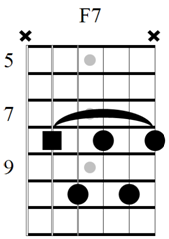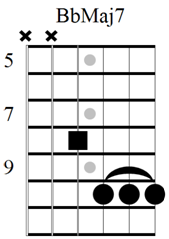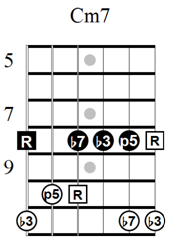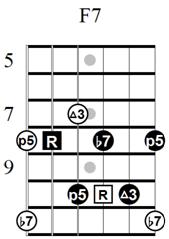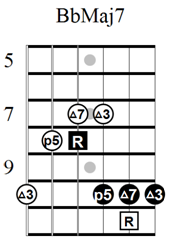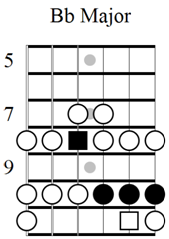Introduction to Jazz Guitar Chord Tone Soloing
Jazz guitar soloing can be a complex affair, especially when it comes to chord tone soloing.
In contrast to modern pop songs, jazz ‘standards’ often change key many times in the space of just one chorus. This level of harmonic complexity can force the soloist to navigate a minefield of theoretical concepts while trying to find something musical and creative to play. It is normally the case that thinking too much while playing is the biggest obstacle to spontaneous creativity.
It is also true, however, that in order to play the right notes at the right time, the soloist must know the chord changes inside out. A deep understanding of how the song is constructed is essential if solos are to flow freely and creatively.
Finding the balance between a cerebral and a truly spontaneous improvisational approach is one of the most important challenges that any jazz musician faces.
Along with understanding and memorising a jazz chord progression, guitarists often find themselves with the additional, instrument-specific challenge of learning to play the correct chords, scales and arpeggios all over the neck. Unlike with the piano, there can be many different shapes to learn for just one arpeggio.
Learning to play all the arpeggio and scale shapes for just one chord is challenging enough, and this task is compounded when you consider that chords are rarely played in isolation. When you solo over two or more chords in a sequence, it can start to feel like you’re walking through treacle.
With hundreds of jazz standards to learn, even finding a starting point can be difficult when it comes to learning to chord tone solo on the guitar.
Introduction to Jazz Soloing on the Major ii V I
Key Centre: Bb Major.
Parent Scale: Bb Major.
The Major ii V I progression is the bedrock on which jazz is formed. It can be heard in almost every tune from the late swing period onwards. It is important to know that in jazz, the iim7 chord was a slightly later addition and found more popularity during the bebop period. In the majority of the swing era, this chord progression was normally written as simply V I. The ii chord was added by bebop players to provide additional soloing options without affecting the tonality of the progression.
Good ‘workhorse’ tunes that feature the major ii V I sequence are:
- Blue Bossa
- Tune Up
- Autumn Leaves
- Perdido
- All the Things You Are
Along with many others.
The process you will learn in this lesson will be repeated in each following lesson using different chord changes. Do not rush the following steps as the work you do now will help build a deep understanding and musical feel for the most commonly played chord changes in music.
Begin by learning the chord progression and chord shape.
Memorise these chord shapes and play them with Backing Track One. These chords form visual ‘anchors’ for everything that follows in this lesson.
The following arpeggios are the ones that you need to know to solo over each chord in turn. Notice that they are built on the previous chord shapes. Try to visualise each chord shape as you play up and down each arpeggio.
Position One Chord Tone Arpeggios:
Use the following steps to help you memorise each arpeggio shape. Before each step, play the chord associated with each arpeggio (shown in black).
- Play the arpeggio ascending from the root. The root is shown by the black square dot.
- Play the arpeggio ascending from the lowest note on the sixth (bass) string.
- Play the arpeggio descending from the highest note on the first (top) string.
- Ascend and descend the arpeggio from the lowest note to the highest.
- Repeat the previous step, but this time say the name of each interval out loud as you play it. For example, for the Cm7 arpeggio above, say, “Root, flat three, five, flat seven”.
When you can comfortably play these arpeggios, try linking all three arpeggios together using the following steps (you do not need to have memorised each shape yet, it is O.K. to read them from the paper).
- Ascend each arpeggio in turn from the root. Take a short break between each arpeggio.
- Ascend each arpeggio in turn from the lowest note on the sixth string.
- Descend each arpeggio in turn from the highest note on the first string.
- Ascend the first arpeggio from the lowest note, descend the second from the highest note and then ascend the third from the lowest note.
- Reverse the previous step.
Be creative with your exercises and find new ways to memorise these arpeggio shapes. Even writing the arpeggios out from memory can be very beneficial if you don’t have a guitar to hand.
When you are feeling confident, it is time to begin the playing some exercises to target chord tones on chord changes. The first task is to focus on a tiny part of the guitar and find as many ways to change between the arpeggios as possible.
Using Backing Track One, begin by isolating the top two strings of the guitar and play four notes from each arpeggio in each bar (1/4 notes).
Chord Tone Soloing Example 1a:
In the previous example, the chord sequence is repeated twice, and on each repetition I have shown a different way to navigate the changes. The only rule is that I hit a chord tone from the new arpeggio each time the chord changes.
The examples in this book are only a starting point. Your task is to find as many ways as you can to navigate between each successive arpeggio. Staying on these two strings, let your fingers go for a walk around the arpeggio shapes and see how many routes you can find to ‘hit the changes’.
When you begin to run out of ideas, switch to the next two-string group, i.e., the second and third strings, and repeat the exercise. Here are two possible routes through the changes.
Chord Tone Soloing Example 1b:
Repeat this process moving across each two-string group: Strings three and four, four and five, and finally five and six.
It should be clear by now that some chord tone notes are common to more than one arpeggio. If you wish to repeat a note on a chord change, this is acceptable just so long as the note exists within both arpeggios.
Gradually, you can start focusing on slightly larger string groupings. The following example shows the same exercise played across the second, third, and fourth strings.
Chord Tone Soloing Example 1c:
Find as many ways as you can to navigate the changes using just chord tones on this three-string group.
Work through every possible adjacent three-string group and then progress to chord tones on four-string groups. You will quickly build up a wide variety of ways to link each arpeggio together. All the work you do here will pay huge dividends in the future.
As you get better, start doubling up some of the rhythms by adding some 1/8th notes. A great way to begin is to add 1/8th notes on just the final beat of each bar.
Chord Tone Soloing Example 1d:
Repeat this exercise but try varying the beat on which you place the 1/8th notes. Gradually introduce more 1/8th notes to each bar until every single note is an 1/8th.
Joining the Dots
The next stage in the process of chord tone soloing is to play a non-arpeggio note on beat four of each bar. There are three ways to do this.
- With chromatic passing notes: A chromatic passing note fills in a one-tone gap between arpeggio notes in different chords.
- With scale tones: A scale tone can also be used to fill in a gap, but the scale tone will always come from the chord’s parent scale. In this lesson, the parent scale is Bb Major.
- With chromatic approach notes. These are just like chromatic passing notes, but they can be played either side of the target tone.
These three techniques are the most commonly used decorations in jazz music and they are always used to smooth out the transition between notes in different arpeggios. This is easier to see and hear musically.
Study the following example carefully. Pay attention to the first five notes.
Chord Tone Soloing Example 1e:
On beat four of the first bar, I have added a chromatic passing note to fill in the gap between chord tones of the Cm7 and F7 arpeggios. Even though this note has nothing to do with either arpeggio, it bridges the gap between the notes in the arpeggios. The sequence of notes beginning on beat three is G, G#, A; and forms a chromatically rising melody.
The same technique is used at the end of bar two, where I join the b7 of the F7 arpeggio (Eb) to the 5th of the BbMaj7 arpeggio (D). The sequence of notes is Eb, E, F.
This idea is repeated in bar four, where I link the 5th of the BbMaj7 chord (F) to the 5th of the Cm7 chord (G) using the chromatic note ‘F#’.
Whenever there is a one-tone distance across a chord change, it can be filled with a chromatic passing note in this way.
In bar five, I use a scale tone to link the chords of Cm7 and F7. The scale tone works in the same way as a chromatic passing note, but the note comes from the tonic Bb Major scale:
I used a scale tone because the distance between the changing arpeggio notes was greater than a tone and the scale tone was the smoothest way to link the two notes.
Finally, between bar five and bar six I used a chromatic approach note.I used a chromatic approach note because the last note of the F7 chord (Eb) and the first note of the Bb chord (D) wereonly a semitone apart and, therefore, there is no gap that I can fill chromatically.
I needed to play something on beat four to lead into the BbMaj chord so I ‘leapfrogged’ the target note (D) and played a note one semitone below the target note (C#). This meant that I could surround my target note by a semitone on each side.
This is a very common technique and the three notes together (Eb, C# and D) form an important melodic structure called an enclosure. Think of an enclosure as a sandwich with the target note as the filling.
The following example shows another route around the changes and makes use of all three techniques described above. Each technique is marked on the music.
Chord Tone Soloing Example 1f:
Analyse the previous example to make sure that you understand how the different techniques function. Reread from the ‘Joining the Dots’ heading if you are unsure of anything.
The most important concept to work on is the chromatic passing note pattern. This is when you fill in a one-tone ‘hole’ between arpeggios. Begin by adding a chromatic passing note on beat four of the bar because this will add to the strength of the melodic line when targeting the arpeggio note in the next chord.
If no chromatic passing note is available, then try ‘sandwiching’ the target note with a chromatic enclosure (approach note) or targeting it via a scale step using the Bb Major Scale.
Begin with simple, two-string groupings and explore as many ways as you can to join the dots using a chromatic passing note on beat four.
As you gain confidence and vision, gradually start using three-string and four-string groupings.
Finally, begin to introduce 1/8th notes just as you did in example 1d. The following example shows just one way to add 1/8th notes to beat four of each bar.
In the next lesson we will be looking t how to add rhythm and more interest to your chord tone soloing ideas.
Check it out here!
For more jazz guitar chord tone soloing ideas, check out my book
“The artists you work with, and the quality of your work speaks for itself.”
Tommy Emmanuel
© Copyright Fundamental Changes Ltd 2024
No.6 The Pound, Ampney Crucis, England, GL7 5SA



